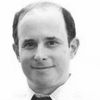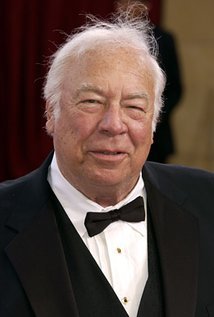I was sorry to hear that George Kennedy passed away on Monday. Happily, he lived a good, long life and made it to 91. Because of the vast career he had - 58 years! (And as recently as 2014) -- it probably gets overlooked, but he won an Oscar as Best Supporting Actor in 1967 for Cool Hand Luke. But I remember him most for the Naked Gun films, since I worked with him on the series, during my ne'er-do-well days as a film publicist.
George tended to play a tough guy a lot -- and he was imposing, a tall, hefty guy. But he was also quite a nice fellow, and a pleasure to work with. Never demanding, and pretty accommodating. He also was exceedingly professional, and one of my favorite moments on the films is a bizarre, odd one for a person to appreciate as much as I did, and it centered on George.
For inexplicable reasons, I absolutely love excellence of craft. It doesn't have to be anything big or flashy, but when people do things exceedingly well (whatever the job or activity), I love it. And there was a scene in Naked Gun 2-1/2 that was just a pleasure for me to watch, even if it was mind-numbingly boring for everyone else.
The scene took place in a bar, and Frank Drebin (played by Leslie Nielsen) had been broken up from his beloved Jane (played by Priscilla Presley) and was drowning his sorrows. George Kennedy's character Ed comes over to buck up his spirits, and when he notices that Jane is across the room, encourages him to talk to her. "Go to her, Frank. Go onnnnn."
Leslie had a lot of dialogue in the scene, and did it well, but there was always something that wasn't exactly the way he or director David Zucker wanted it. George didn't have nearly as much to do compared to Leslie, whose character was lost in a funk and unburdening himself, but George still had to repeat it all every take, of course. And he was impeccable, each time. As the takes went on, I stationed myself nearby to watch these two craftsman do the scene over and over, probably 10-15 times, and what I most loved is that each time, George Kennedy delivered that one particular line, "Go to her, Frank. Go onnnnn," almost exactly the same, every single take. The same pacing, same slight pause, same inflection, same stretching of the word, "onnnnn." I just absolutely loved watching it.
This is the scene. No need watch the whole thing, it's long (but pretty funny, so you might want to...), but if you prefer to jump to that single line, it comes in at the 2:54 mark
There's one other thing that I'll always remember about George.
This is something that most people are unaware of, bordering on the totally unknown. But during the filming of Naked Gun 33-1/3, he got extremely ill. It was an odd illness, sort of a case of vertigo, for lack of a better word. He had great difficulty standing, and it left him intensely weak. It was so problematic that for a very difficult day when it all came down and hit him, the filmmakers really didn't know what they were going to do. You couldn't recast him, it was a sequel, and they'd already been filming for a couple weeks. You couldn't really write him out of the script, but they might have to. There was the thought of changing the schedule on the hope that he'd be better later, though that was uncertain and impractical. In the end, George, who was pretty darn tough (he'd been a Marine, and for a long while expected that would be his career), solved the issue: he insisted he would stay on the film and make it through.
And he did. But it was incredibly demanding. He eventually recovered, but not till after filming was over. So, for the rest of shooting, he stayed in his trailer, conserving his strength, usually lying down all day, and only right before they needed him at the very last minute, would he carefully, slowly make it to the set. (I don't recall if they had a wheelchair for him, but I suspect so.) And director Peter Segal re-staged scenes so that George could either be seated as much as possible, or stand in just one position. No walking around and talking -- because he simply couldn't do it. But he made it through (helped by his above-mentioned professionalism of not having to keep redoing endless takes, which were kept at a minimum), and it's almost imperceptible in the finished film. I'm guessing almost no one watching the movie has a clue.
There are really only two scenes I recall when you can sort of see he's having difficulty. One is a scene when he and Norberg (played by O.J. Simpson) go to Frank Drebin's house to convince him to come out of retirement. George has a slight difficultly plopping down into the couch, but the most noticeable moment is when Leslie Nielsen gives him a cupcake he's baked, and George is so weak he has a hard time holding it and taking a bite. (Yes, that's how tough it was for him -- and how tough a guy George was to make it through the entire film.)
The other scene is the famous opening, that's a spoof of the classic "Potemkin Steps" scene from Battleship Potemkin and the homage that The Untouchables did in a train station. George was undercover as a redcap porter, and had to stand throughout it, while fumbling for his gun. And he does it wonderfully, though there are a few moments if you know precisely what you're looking for where you can see him battling through. (Fortunately, he was given a baggage cart and then a baby carriage to balance on.)
But he did it. And he completed the whole movie. And it was a seriously-impressive achievement.
When we had the cast party, he still wasn't well-enough to attend, yet he dearly wanted to be there. He'd made three movies with this group, both cast and crew, and he felt close to everyone. So, he had the driver, who the company assigned to him for the film, take him to the restaurant and -- even though he couldn't go inside and stand around and dance and socialize -- he sat in the car all night in the parking lot, just so he could be part of it. And those of us who knew he was there, would go out to his car throughout the night to visit with him, and bring food and drink and celebrate.
He was a good guy. He had a long life.
And here's that opening scene I mention above. And it's all the more impressive because, if I remember correctly, this was filmed the very day he first came down with his illness -- when the powers-that-be were freaked out because they had absolutely no idea what they were going to do. And more than anything, George wanted to show the filmmakers that he could do it. And he did.
*
To read more from Robert J. Elisberg about this or many other matters both large and tidbit small, see Elisberg Industries.

